
Andy Lloyd's Dark Star Blog

Blog 47 (February 2017)
Seven Planets Found in Red Dwarf System
NASA made a big announcement this week about new exoplanets found orbiting the dwarf star TRAPPIST-1 some 39 light years away. I've discussed this particular dwarf star system before (1), as it was already known to have three terrestrial planets in attendance orbiting very close to this cool, fairly dim star (2,3). The dwarf star is approximately one tenth the size of the Sun, and it's mass places it on the border between a brown dwarf and a red dwarf star. Unusually for a star this small, TRAPPIST-1 has a high metallicity, which actually exceeds that of the Sun (4).
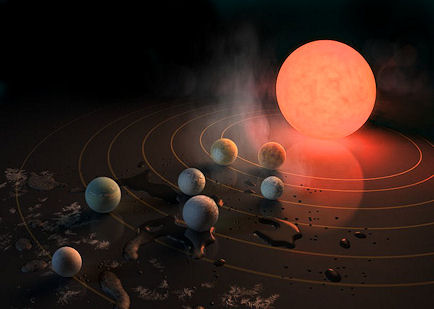
A more realistic colour scheme for the miniature TRAPPIST-1 system
Now, an international team of astronomers, using the Belgian TRAPPIST telescope in Chile and the Spitzer infra-red space telescope, have released details about a further four terrestrial planets in this mini-star system, three of which (e, f and g) are located within it's habitable zone, where temperatures favour the presence of liquid water (5):
"Researchers led by Michaël Gillon, of the University of Liège in Belgium, have been studying the infrared light emitted by this miniature star and have detected drops in luminosity characteristic of transits, i.e. the passage of astronomical bodies moving across its face. As early as 2015, the first three planets (dubbed b, c and d) had been identified. Tracking the system using TRAPPIST and the space telescope Spitzer, the team was then able to identify four others planets (e, f, g and h) in 2016. Based on the frequency of these transits and the degree of reduction in luminosity of the star, they have demonstrated that these seven planets are all comparable in size to Earth (to within 15%), and orbit very close to their star." (6)
These planets have an approximately resonant relationship with one another. It's highly unusual to discovery such a string of planetary pearls as these, so there's no real way of knowing whether this is a 'normal' relationship. But in this case, at least, it is thought that these planets must have migrated inwards from their original orbital positions, and this resonance came about from interactions between them as they did so (5).
This I find most interesting. We have here a precedent for the inward migration of a set of terrestrial planets which originally formed from TRAPPIST-1's proto-planetary disk at a much greater distance. In so doing, they established a resonant relationship with one another as the planetary system settled down into an equilibrium state. If such an arrangement is thought to happen here, could it not also have occurred in the early solar system? Could Mercury, Venus, Earth and Mars all have begun life further out in the solar system before migrating inwards, and establishing their own sequential equilibrium (the basis of which led to the now-superceded Titius-Bode Law)? As an advocate of the possibility that Earth began life where the asteroid belt is currently located, I find this development very encouraging.
The phrase 'ultra-cool dwarf star', which has been used widely to describe TRAPPIST-1, may be misleading. Indeed, the phrase was used by the team of international scientists working on TRAPPIST-1 system in the titles of their published papers in Nature (3, 5). As mentioned, at ~83 Jupiter masses, TRAPPIST-1 is on the borderline of being able to burn hydrogen - unlike its smaller brown dwarf cousins. 'Ultra-cool' is usually used to denote a sub-brown dwarf, whose mass lies below the 13 Jupiter mass point where deuterium starts to burn. Red dwarfs are simply smaller, cooler cousins of yellow dwarf stars, like the Sun. The term 'ultra-cool' makes it sound like these objects lie way down at the bottom of the stellar spectrum, when in reality there is an additional spectrum of brown dwarfs and, yes, 'ultra-cool' sub-brown dwarfs beyond.
Then there's the colour, which is a related issue. Many of the published artistic images of TRAPPIST-1 and its seven planets show the central star appearing yellow, much like our Sun. However, at 83Mj, TRAPPIST-1 would appear red. I could understand how this might happen in the mainstream media, who would know no different about such matters. However, it's not at all clear to me why NASA's own writers would place illustrations showing TRAPPIST-1 as a golden sun-like star in its own official press release (7). This contrasts with their more accurate depiction of the TRAPPIST-1 red dwarf system in a NASA press release the previous year (8). Do they simply want to appeal to a wider audience by giving the impression of habitable planets around a familiar yellow star? Or do they want to avoid the conspiratorial connotations associated with seven planets orbiting a red star (for which I must reluctantly claim some credit)?
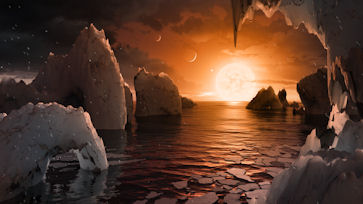
NASA's golden TRAPPIST-1 system (7).
Image credit: NASA/JPL-Caltech
What's even weirder, for me at least, is that NASA's new artistic impression of the view of the TRAPPIST-1 system - as seen from one of its habitable planets - is very, very similar to my own painting created for the cover of my 2005 book 'Dark Star' (9).
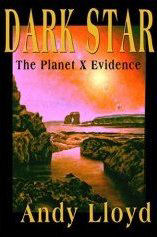
NASA's image is very similar to the front cover of Dark Star
Given the miniature nature of this red star and its tiny system of seven planets, I have to wonder whether this is a coincidence? After all, such a description bears a remarkable resemblance to the Dark Star system I've been writing about for the best part of two decades. Makes you wonder whether 'Dark Star' is sat on the bookshelves of some of NASA's own people, doesn't it?
Back in 2008, one of my fellow researchers, Al Cornette, wrote a book entitled "Seven Mountains and the Red Star", which discussed a possible return of Nibiru for 2012. This poetic description bears a rather uncanny resemblance to the planetary format of TRAPPIST-1 (which I'm now tempted to think of as 'Cornette's Star'). In our respective books, Al and I both wrote about the Planet X phenomenon, whose description of a sizeable red planet and accompanying set of seven moons originates from the writings of Zecharia Sitchin (11).
Now, neither of us are even hinting that TRAPPIST-1 might be this system. TRAPPIST-1 lies almost 40 light years away, whereas the Dark Star system (or planet Nibiru/Marduk as Sitchin described it) is necessarily orbiting our own Sun, whose influence extends to perhaps a single light year at best. Nonetheless, both of us feel somewhat vindicated that these miniature planetary systems are a reality, and may offer the conditions for life in our galactic neighbourhood. An important precedent has clearly been set.
Written by Andy Lloyd, 23rd February 2017
References:
1) Andy Lloyd "Earth-like Planets Orbiting Ultra-Cool Dwarf Star" 26 May 2016,
andylloyd.org/darkstarblog38.htm
2) European Southern Observatory press release "Three Potentially Habitable Worlds Found Around Nearby Ultracool Dwarf Star" 2 May 2016, ESO1615,
3) Michael Gillon et al "Temperate Earth-sized planets transiting a nearby ultracool dwarf star" Nature, 533, 221-224, 12 May 2016
4) "TRAPPIST-1"
5) M. Gillon et al "Seven temperate terrestrial planets around the nearby ultracool dwarf star TRAPPIST-1," Nature, 542 (7642): 456, 23 February 2017
6) CNRS "A Planetary System that Could Support Life" 22nd February 2017, with thanks to Eitan
7) NASA Press Release 17-015 "NASA Telescope Reveals Largest Batch of Earth-Size, Habitable-Zone Planets Around Single Star" 22 February 2017,
8) NASA Press Release 16-076 "NASA’s Hubble Telescope Makes First Atmospheric Study of Earth-Sized Exoplanets" 20 July 2016
9) Andy Lloyd "Dark Star: The Planet X Evidence" Timeless Voyager Press, 2005
10) Al Cornette "Seven Mountains and the Red Star" Earth MacroVision, 2008
11) Zecharia Sitchin "The Twelfth Planet" Avon Books 1976
The Lost Oceans of Venus
Water is a common component of the solar system. It is increasingly turning up in places which were hitherto considered to be arid places - Mars, the Moon, various moons. There is a conflict between the initial general availability of water in the proto-solar nebula, which implies the universal presence of water across the early solar system, and the action of the Sun and its solar wind to drive it away. The electric field conditions in the space enveloping planets plays a significant part in gradually stripping away the upper layers of atmosphere (1), with lighter gaseous molecules (like hydrogen) more likely to be driven away than heavier gaseous molecules (oxygen, nitrogen, carbon dioxide, water vapour). As hydrogen is increasingly lost from planetary atmospheres over time, the capacity for water to be formed chemically is lowered. Inevitably, planets in the inner solar system dry out.
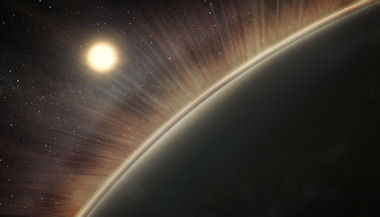
Image credit: NASA/Goddard/Conceptual Image Lab, Krystofer Kim
Which makes the abundant presence of water on the surface of the Earth something of a mystery. It seems at odds with the arid nature of its neighbours (although, as noted, the presence of water ice on these other worlds is often more significant than previously thought). For many years, the dominant argument to explain this was the later veneer theory, whereby the planets were constantly re-supplied with water by the impact of comets, which were perceived as being dirty snowballs hurtling around the solar system.
That theory has been in jeopardy for a while now. Firstly, comets do not appear to be the huge repositories of water ice that they were once assumed to be (instead, they appear more like asteroids, which 'outgas' volatiles from largely internal icy stores when heated by the Sun, during their perihelion passages). Secondly, with the exception of comet 103P/Hartley 2 (2), the isotopic composition of the water of comets from the outer solar system unexpectedly bears little resemblance to the Earth's water (3). Instead, the Earth's water more closely resembles that and water ice on objects found in the asteroid belt, and inner solar system (4, 5).
The ratio of regular hydrogen to deuterium (the heavier, neutron-bearing form of hydrogen) varies according to the mix and origin of the water. So, as hydrogen is stripped away from a planet, the lighter form is driven away more easily than the heavier form. Over time, what is left is an increasingly heavy mix. This deuterium-to-hydrogen (D/H) ratio can provide clues to the origin of water, for the various bodies of the solar system, and how they interact.
The complex picture that has emerged over the last few decades has been the subject of many of my articles (6, 7). That's because I consider it to offer strong evidence for an alternative origin for the Earth. My colleague Lee Covino and I noted some years ago that the ability to roughly place solar system objects into zones according to their D/H ratios might help to prove that the Earth began its life where the asteroid belt is now. This would be consistent with Zecharia Sitchin's theory about the intrusion of a rogue planet into the early solar system, the result of which was a cataclysmic event which caused the Earth to substantially migrate inwards (8). We predicted, based upon this hypothesis, that the Earth's waters would share a common composition with those of the asteroids (6). And so it has been largely proven since.

The watery world Tiamat faces the incoming planet Nibiru/Marduk
A recent scientific paper considered the extent to which water was available on the young planet Venus. Based upon the D/H ratio of water in the Venusian atmosphere, it has been known for some time that there must have been substantial amounts of water during the early life of the planet Venus. The question is how long did it hold onto that ocean, and at what point did the runaway greenhouse effect transform Earth's sister world into the hellish place it is today? According to the results of the latest computer simulations (which take into account the planet's strangely slow rotation, topography and atmospheric composition), the answer is that Venus may have maintained its ocean up until a relatively short time ago (9):
"Venus has a deuterium-to-hydrogen (D/H) ratio that is 150 ± 30 times that of terrestrial water but is currently a parched world... The D/H ratio implies that Venus has lost substantial quantities of water over its history, but it is unclear when and at what rate. When continuing exogenous and endogenous sources are included, the primordial value is very poorly determined. However, modern formation models indicate a great deal of mixing among terrestrial planet protoplanets [citing 10], strongly suggesting that Venus and Earth did not form with 5 orders of magnitude difference in water inventory." (11)
One thing's clear - the early inner solar system had a lot more water than it does now, with both Mars and Venus having had oceans. In Venus' case, the water was stripped away. Perhaps the same with Mars, or perhaps it's still there under the regolith. But Sitchin was right - these were watery worlds, and whether Earth started in its current location or in the asteroid belt, it seems likely then that it too had much greater quantities of water. Sitchin described the primordial Earth as being a larger, more watery world - in the Babylonian cosmic myth, she took the form of the watery monster Tiamat, which was rendered in two by the usurper god Marduk (8). It seems as though Venus, too, was a habitable world at that time, and possibly far more amenable to life than our own relatively frigid world.
Written by Andy Lloyd, 5th February 2017
References:
1) Bill Steigerwald ‘Electric Wind’ Can Strip Earth-like Planets of Oceans, Atmospheres" 20 June 2016
2) Paul Hartogh et al "Ocean-like water in the Jupiter-family comet 103P/Hartley 2" Nature, 478, 218-220, 13 October 2011
3) ESA "Rosetta Fuels Debate on Origin of Earth's Oceans" 10 December 2016
4) Linda Martel "Water, Carbonaceous Chondrites, and Earth" July 2012
5) Conel Alexander et al "The Provenances of Asteroids, and Their Contributions to the Volatile Inventories of the Terrestrial Planets", Science, 337: (6095), p. 721-723, 10 August 2012
6) Andy Lloyd "The Great Water Conundrum" from 2002 onwards
7) Andy Lloyd "Earth's Primordial Waters" 24th November 2015
andylloyd.org/darkstarblog32.htm
8) Zecharia Sitchin "The Twelfth Planet" Avon Books 1976
9) Michael Cabbage & Leslie McCarthy "NASA climate modeling suggests Venus may have been habitable" 11 August 2016
10) Alessandro Morbidelli et al. "Building terrestrial planets", Annu. Rev. Earth Planet. Sci., 40, 251–275, (2012)
11) Michael Way et al "Was Venus the First Habitable World of our Solar System?" Geophysical Research Letters, 28 August 2016,
Enoch's Vision of the Dark Star System
I've been reading Nick Redfern's latest book, entitled 'Immortality of the Gods' (1). It's quite Sitchinite in content in places, with plenty of references to the Anunnaki and their great longevity. During the course of his analysis of ancient texts, and their allusion to the immortality of the gods, Redfern re-prints a translation from the apocryphal Book of Enoch, describing the Biblical patriarch's flight (through space?) with a band of angels, including Uriel.
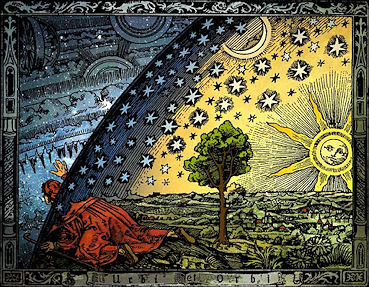
Flammarion Woodcut 1988
Part of that passage seems to me to describe their visit upon the Dark Star system, in the outer reaches of our solar system. I've described this before, a long time ago, but want to highlight this passage once again as it has an added importance in recent times:
"I proceeded to where things were chaotic. And I saw there something horrible: I saw neither a heaven above nor a firmly founded earth, but a place chaotic and horrible. And there I saw seven stars of the heaven bound together in it, like great mountains and burning with fire. Then I said: 'For what sin are they bound, and on what account have they been cast in hither?'
"Then said Uriel, one of the holy angels, who was with me, and was chief over them, and said: 'Enoch, why does thou ask, and why art thou eager for the truth? These are of the number of stars, which have transgressed the commandment of the Lord, and are bound here till ten thousand years, the time entailed by their sins, are consummated.'" (2)
The Book of Enoch contains a great many astronomical references and secrets. I've argued before that these seven stars/mountains are the planets of the Dark Star system, probably including the fiery Dark Star itself (a sub-brown dwarf). The torrid, chaotic environment of that place alludes, I believe, to the way it is wrapped up into a dark nebula of dust, gas, and interstellar medium, as I've described in recent blog posts (3,4), and in a science paper I wrote last year (5) which aimed at solving the inexplicable lack of a direct sighting of the proposed Planet Nine object (6).
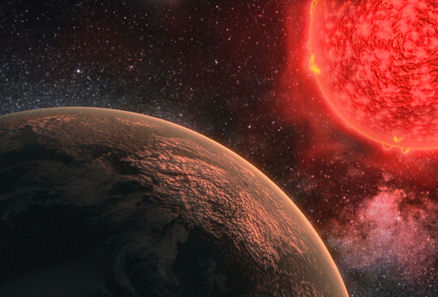
Given the red glow of the Dark Star emanating from within this dense, localised gas cloud (which is blown back by the galactic wind to provide the quintessential Winged Disk appearance of the system), and its fiery reflection upon the inner planets orbiting it, then one can readily appreciate the description provided in the Book of Enoch.
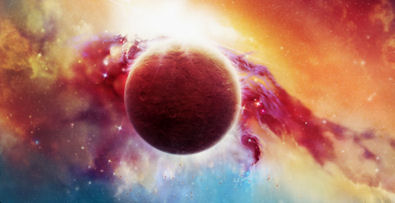
Additionally, the passage from The Book of Enoch discusses a timeframe of ten thousand years. I would suggest that this alludes to the period of time which has yet to pass before the Dark Star system returns to its perihelion position. The first passages of the non-canonical Book of Enoch (known as the Book of the Watchers) was probably penned around 300 BCE, but is likely based upon oral accounts from centuries, if not millennia before that.
It would be foolish to try to calculate timings from this, but certainly suggests that ten thousand years represents a fraction of total orbital period of the Dark Star system. One may imply, then, that the full extent of its eccentric orbit may by between ten and twenty thousand years, or perhaps more. This is in line with estimates for Planet Nine, whose existence has been inferred indirectly from its perturbing effect upon a cluster of anomalously extended (or scattered) Kuiper Belt Objects (6).
Written by Andy Lloyd, 11th February 2017
References:
1) Nick Redfern "Immortality of the Gods" New Page Books, 2017, p43,
'Immortality of the Gods' by Nick Redfern
2) R.H. Charles (Translator) "The Book of Enoch" 1912
3) Andy Lloyd "Dust in the Winged" 23 June 2016,
andylloyd.org/darkstarblog39.htm
4) Andy Lloyd "Interstellar Planet Formation" 8th-17 July 2016
andylloyd.org/darkstarblog40.htm
5) Andy Lloyd "The Cumulative Effect of Intermittent Interstellar Medium Inundation Upon Objects In The Outer Solar System" Feb 2016, DOI: 10.13140/RG.2.1.5112.5526 - an updated version (22/2/16) is available here:
6) K. Batygin & M. Brown "Evidence for a Distant Giant Planet in the Solar System" 20 January 2016, The Astronomical Journal, 151: 2,
An Opportunity to join the Hunt for Planet Nine
NASA have
invited budding armchair scientists to join the hunt for Planet Nine
(1). Although a planet thought to be approximately ten times the
mass of the Earth is causing otherwise inexplicable changes to the
orbits of various distant bodies in the solar system, it has yet to be
observed directly.
Image credit: NASA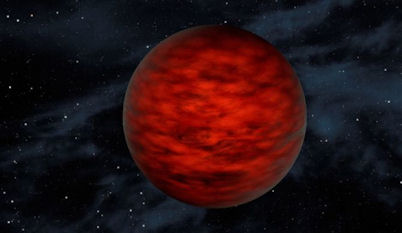
One of the mysteries here is why it was not spotted by the infra-red survey, WISE, carried out in 2009-2010. There is strong indirect evidence for this sizeable Planet X object. But somehow it has managed to evade detection, even though, all things being equal, it should have shown up fairly easily in the sensitive and wide-ranging WISE survey. So, what's going on?
Reading between the lines. it becomes clear that the WISE survey was not as foolproof as we were led to believe. After the extensive WISE data had been pored over by scientific teams, NASA announced the death of Planet X, as well as possible sub-brown dwarfs in our backyard (2). Since then, compelling evidence for at least one planet (3) has brought into question the effectiveness of NASA's search. The appeal for volunteers to trawl through some of the WISE data to pinpoint 'false-positives' indicates that scientists recognise that the computer analyses of the changing sky over time may not have been as thorough as previously claimed. Sometimes, human observational skills are more effective at spotting anomalies.
The take-up of the challenge appears to be high, and at the time of writing the work is almost halfway through. There are no shortage of people wishing to play their part in finding a new planet in the solar system!
There's a possibility that
they might also help to find other, larger objects, like sub-brown
dwarfs located between Neptune and the nearest local stars:
"Instead of finding the mysterious Planet Nine,
it’s entirely possible the armchair astronomers could spot traces of
brown dwarfs, strange low-mass projects that emit very little light, but
glow with infrared radiation. They measure somewhere between a star and
a Jupiter-sized planet in size and could be lurking outside the solar
system between Neptune and the nearest star, Proxima Centauri, along
with Planet Nine." (2)
'Entirely possible'? How things have changed in just the last couple of years! The hunt for local brown dwarfs seems to be very much back on...
Written by Andy Lloyd, 18th February 2017
References:
1) Marc Kuchner "Backyard Worlds: Planet 9"
2) Whitney Clavin & J. D. Harrington "NASA's WISE Survey Finds Thousands of New Stars, But No 'Planet X'" 7 March 2014
3) K. Batygin & M. Brown "Evidence for a Distant Giant Planet in the Solar System" 20 January 2016, The Astronomical Journal, 151: 2,
4) Coburn Palmer "Armchair Astronomers help NASA search for mysterious Planet Nine" 16 February 2017, with thanks to Lee
More Evidence for Planet Nine
Spectroscopic analysis of two of the extended scattered disc objects belonging to the Planet Nine cluster shows that they share a common origin. There are seven objects in this cluster. These objects share common orbital features: namely, significant anisotropies in the distributions of their directions of perihelia (i.e. the vector from the Sun to their respective perihelion point) and orbital poles. The statistical likelihood that there is not an extraneous influence perturbing their orbits is vanishingly small. Hence, the realisation among many mainstream astronomers that there really is a massive Planet X object out there, awaiting discovery.
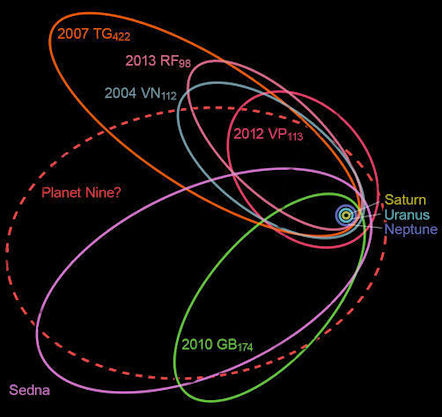
The cluster of extended scattered disc objects with an unconventional 'aligned' relationship with the proposed Planet Nine
In addition to the shared orbital features described above, the orbital paths of two of these objects, 2004 VN112 and 2013 RF98, currently both lying in the constellation Cetus, are also practically identical (1).
"Assuming that the angular orbital elements of the ETNOs [Extreme Trans- Neptunian Objects] follow uniform distributions (i.e. they are unperturbed asteroids moving in Keplerian orbits around the Sun), the probability of finding by chance two objects with such a small angular separation between their directions of perihelia and, what is more important, also between their orbital poles is less than 0.0001, which suggests a common dynamical origin." (2)
By itself, that does not
necessarily mean that the two objects share a common physical origin.
However, the new visible spectroscopic analysis carried out by the
Spanish team using the OSIRIS
camera-spectrograph at the 10.4 m Gran Telescopio Canarias (GTC)
shows that the two extreme Trans-Neptunian objects share a very similar
light signature - which is also in keeping with some of the other
members of the Planet Nine cluster (3), including 2000 CR105
and 2012 VP113 (2).
Sedna is an exception, and likely derived originally from the inner Oort
cloud.
There are two possible explanations
to explain this level of coincidence: (1) a large
object broke up relatively recently at perihelion and 2004 VN
As a result of these deliberations, the conclusion
has been drawn that 2004 VN112 and 2013 RF98
must have once been a wide binary pair of trans-Neptunian asteroids.
Upon being perturbed by Planet Nine at aphelion, they were scattered
apart from their common point of origin.
"The team performed thousands of numerical
simulations to observe how their orbital poles would separate over time,
revealing that a possible planet with a mass between 10 and 20 Earth
masses orbiting the Sun at a distance of 300-600 AU could have caused
the split around 5 and 10 million years ago. "‘The similar spectral
gradients observed for the pair 2004 VN112-2013 RF98 suggests a common
physical origin,’ says first author Julia de Leon. ‘We are
proposing the possibility that they were previously a binary asteroid
which became unbound during an encounter with a more massive object."
(1)
The Spanish team's measurements allowed them to hone the values of the ETNOs' orbital paths; in particular of 2013 RF98, which had a previously had a rather uncertain orbital determination. Their resulting values for the Planet X body perturbing these ETNOs were similar to those produced by Harvard astrophysicists Holman and Payne in 2016 (4).
Written by Andy Lloyd, 25th February 2017
References:
1) Cheyenne MacDonald "Planet Nine breakthrough as astronomers find asteroids that may have been victims of a 'smash and grab' by mysterious body" 21st February 2017, with thanks to Lee
2) J. de León, C. de la Fuente Marcos & R. de la Fuente Marcos "Visible spectra of (474640) 2004 VN112-2013 RF98 with OSIRIS at the 10.4 m GTC: evidence for binary dissociation near aphelion among the extreme trans-Neptunian objects" Monthly Notices Royal Astronomical Society Letters, 467 (1): L66-L70, 10th January 2017
3) Konstantin Batygin & Michael Brown "Evidence for a Distant Giant Planet in the Solar System" The Astronomical Journal, 151:2, 20 January 2016,
4) Matthew Holman and Matthew Payne “Observational Constraints on Planet Nine: Astrometry of Pluto and Other Trans-Neptunian Objects”, The Astrophysical Journal, 152: 80, 30 Mar 2016,
arxiv.org/pdf/1603.09008v1.pdf
New Academic Paper
Last year, I published an article entitled "Nibiru and the Younger Dryas Boundary" on the Dark Star Blog. The short essay brought together a number of ideas which I presented in Rome that month, at one of the regular conferences organised by Massimo Fratini. I've referred back to this item a few times now, and commented upon it on various online forums on Facebook, attracting some interest. Some more ideas have formulated around this over time.
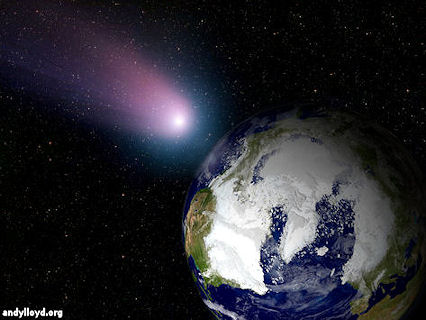
So, rather than re-hashing old ground on the Blog, I've decided to smarten up and update the essay, and publish it on Academia.edu, where it is now available to download (1). The newer version begins to explore the possibility that the very ancient archaeological site of Göbekli Tepe, at the edge of the Taurus Mountains in Turkey, was the refuge for survivors of the Flood in the Levant, during the end of the last Ice Age. The remarkable imagery carved into the monuments there appear to have astronomical motifs, and I believe them to be a warning to later generations describing the appearance of unusual celestial imagery just prior to the catastrophe.
Written by Andy Lloyd, 17th February 2017
References:
1) Andy Lloyd "Planet X and the Younger Dryas Boundary" 16 February 2017
Update on The Red Star of Ruin
Following on from last month's blog item entitled, 'The Red Star of Ruin', I received this fascinating email which I have permission to share with my readers:
Hi Andy,
I
caught your 2015 interview with Kerry Cassidy tonight. I don't know how
I'd previously missed it but she mentioned it a week or so ago, to
someone else she was talking to. Although this is not really my area or
subject matter (at least not from a technical viewpoint), I've been
interested in the Nibiru story since I discovered it around 2001 and I
have noticed, of late, a lot of very recent photo and video footage by
various amateur astronomers, showing what appears to be the same anomaly
that you spoke of; that being shots of the sun with a secondary light
source to one side of it. Therefore, when Kerry Cassidy mentioned your
interview I wanted to check it out. I went to your site afterwards and
had a skim through your latest blog. After reading the "Red Star of
Ruin" I think I might have a tiny piece of the puzzle for you to slip in
there.
It seems that you can't nail down an origin for this story. In 1998 I was researching a lot conspiracy stuff with the intention of writing a screenplay. It got finished but never saw the light of day as a film, although I did eventually release it as an album. I read a lot of books on many subjects, one of which was 'The Head of God' by Kieth Laidler. Laidler was, apparently, the chief researcher for David Attenborough during one of his TV series (the secret life of plants I think), so he knows how to research information. The book was about the head of Jesus and/or that of John the Baptist, being removed after death and preserved in an Ivory box that was kept in the Ark of the Covenant and found by the Templars under the ruins of Solomon's Temple.
A lot of his research was about the Cult of the Severed Head in Egypt, a cult of which Jesus is supposed to have been a member during his "wilderness years". In telling his story he points out that Akenahten, for reasons that escape my memory, got wind that he was in danger of being assassinated along with his daughter Scota. Plans were made for her to get out of Egypt and she took off with her entourage, taking with her a large marble or granite throne. They made their way to the Med, into Spain, then the south of France, through France to Normandy, across to Cornwall, into Wales and finally across the Irish sea to Ireland where they settled.

The Scottish Stone of Scone
The throne was deposited in the north of the country and became the
throne on which the subsequent Kings of Ireland were crowned and is, if Laidler is correct, the real Stone of Scone and not the Scottish brick
that was kept in London for all those years. Leaving behind a large
Egyptian contingent, Scota eventually went across the sea where she
became the the ruler of the land to which she gave her name, Scotland.
He also points out that the predominant red hair of the Irish and the
Scots is a direct result of interbreeding between the Egyptians and the
locals.
Given that the Egyptians are said to have had a good knowledge of the Stars and their movement, it's not unreasonable to assume that this story of the Red Star of Ruin came directly from those that had scientific knowledge of Nibiru.
I hope you find this helpful.
Dave.
Correspondence received 5 February 2017

You can keep informed of updates by following me on Twitter:
![]()
Or like my Facebook Page: https://www.facebook.com/darkstarandylloyd